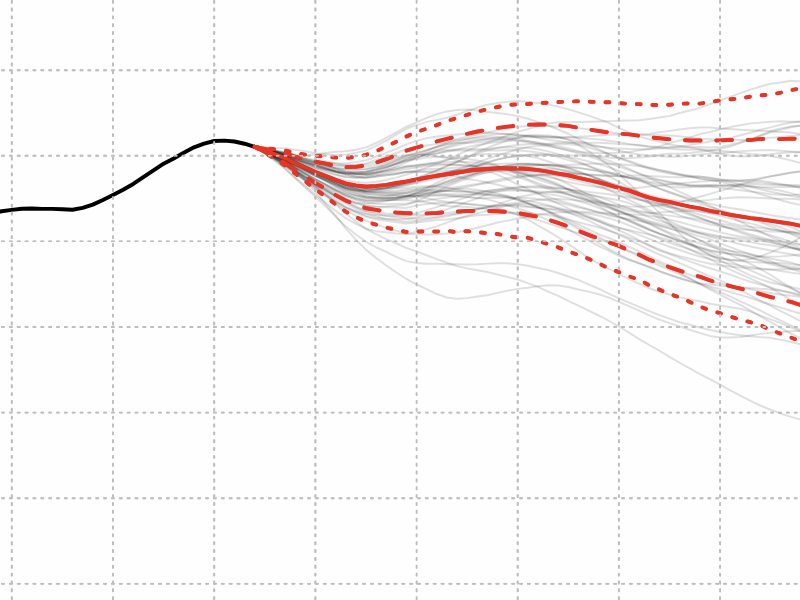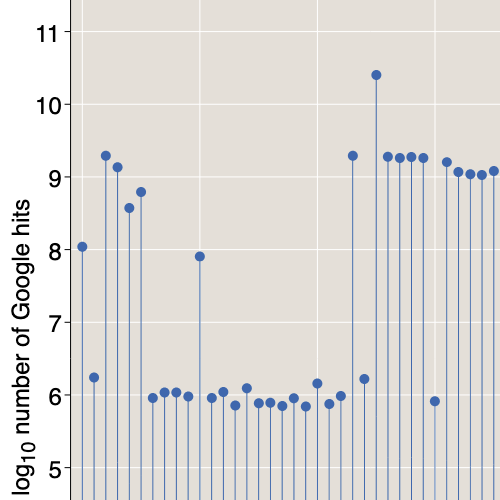Spudging
by Brian Hayes
Published 26 September 2007
Hardware is hard, whereas software is soft; the people who named these things knew what they were talking about.
A while ago, I volunteered to help a friend upgrade the disk drive of an Apple iBook. My first clue that this was going to be a fun project was learning that we needed a special tool called a spudger just to pry open the case. As it turned out, the spudging part of the job wasn’t really that bad; the sleek, black, nylon implement worked quite smoothly. (But so did an old putty knife.) Following instructions , I removed 3 Torx screws, 41 Phillips screws, 1 magnet, 3 rubber feet, 2 greasy springs, 4 strips of sticky tape, the battery, the keyboard, the Airport card, the RAM shield, the lower case, the bottom shield, the DC-in board, the upper case, the top shield, a restraining bracket, and the hard drive. Then I plugged in the new drive and replaced the restraining bracket, the top shield, …, sticky tape, greasy springs, rubber feet, magnet, Phillips screws and Torx screws. Finally, all the parts were back in the box and the case was snapped together again where I had spudged it apart. But when I pressed the power button: Total absence of joy. I pressed it again: Not a peep from the speaker, not a glimmer of light in the screen. Yet again: Nothing but a blank stare.
My purpose in writing about this low point in my career as a high-tech handyman is not to rant about the frustrations of technology or our throwaway culture, where nothing’s worth fixing and nobody knows how to fix it anyway. On the contrary, I want to take a moment to marvel at the elegance and ingenuity of microelectronic technology. After all, it’s the wonder of our age.
I recently had occasion to pull an old book off the shelf: Introduction to VLSI Systems by Carver Mead (Caltech) and Lynn Conway (then Xerox PARC, now University of Michigan).

This is a hands-on, do-it-yourself guide to designing silicon chips—arguably the most complex artifacts ever created by human minds and hands. (When Mead and Conway were writing, “VLSI” meant thousands of transistors on a chip; now it’s hundreds of millions.) Intricate as the circuits might be, Mead and Conway leave you feeling that you can understand absolutely everything about them, from the physics of electrons drifting through doped silicon, to the operation of individual transistors and logic gates, to the organization of those gates into higher-level modules such as adders and shift registers, to the layout of the patterns for the various layers, to the process of fabrication. I’ve always been particularly fond of the colorful layout diagrams, which look nothing like engineering drawings and everything like textile patterns.
Things have changed somewhat since the late 1970s—the era of the circuits described by Mead and Conway. Chip layouts were then checked and documented by printing them out at enlarged scale with a multicolor pen plotter. Quite a few of those plots wound up decorating engineer’s offices. (Maybe that was their real purpose.) If you tried to make a similar plot of a modern chip layout, it would cover a square kilometer. Nevertheless, even though this book is 30 years out of date, it is still the guidebook I would choose to take with me on any visit to the world of digital devices.
In their preface, Mead and Conway write: “In any given technology, form follows function in a particular way.” Yet what’s most extraordinary about the design of silicon circuits is how function follows form. It’s magic: When you print those patterns of interwoven colored stripes onto the surface of a silicon wafer, they come to life! They become active agents rather than mere geometric figures, capable of computing—almost capable of thinking. It’s as if the printed words in a book began reading themselves aloud and commenting on the story in which they occur.
If it’s surprising that mere geometric patterns can be transformed into a computing machine, I sometimes find it equally astonishing that mere machinery can be made to compute. The objects of computation are abstract entities such as numbers, bits, sets, logical operations. These things all seem (to me) to have an existence independent of any specific physical embodiment. When I think of a logical formula—P AND (Q OR R), say—I don’t ordinarily have in mind the little series-and-parallel network of transistors that Mead and Conway would design to implement this function in nMOS technology. P, Q and R are variables, or truth values, not voltages and currents. So why does our universe offer this curious mapping between physical structures and computational ones? Why is it possible to build computers? Why do we need to build them? Why can’t we just compute with pure thought stuff?
A few years ago, if I had written a paragraph like the one above, I would now be awaiting a letter or a phone call from Rolf Landauer, a wonderfully irascible physicist at IBM, who would forcefully remind me that “Information is physical!” Landauer died in 1999, so I no longer have the benefit of his critiques, but I’ve just discovered that his views on this issue are very ably representing in the final chapter of Mead and Conway, a chapter I had not properly appreciated when I first encountered their book. They write:
Computation is a physical process. Data elements must be represented by some physical quantity in a physical structure, for example, as the charge on a capacitor or the magnetic flux in a superconducting ring. These physical quantities must be stored, sensed, and logically combined by the elementary devices of any technology out of which we build computing machinery.
I’m not going to try to argue the contrary proposition—that computation is an abstract, mathematical process, which just happens to be modeled accurately by certain physical events and structures—but I would like to register my ongoing puzzlement at this close correspondence between the world of atoms and the world of numbers. I can believe it’s true that information is physical, but at a deep level I don’t get why it’s necessary.
Consider this: Since 1994, thanks to Peter Shor, we’ve had an algorithm for efficiently finding the prime factors of integers. But the algorithm only works on a quantum-mechanical computer; with a computer built according to the principles of classical physics, all known factoring algorithms require an effort that grows exponentially with the size of the integer. Someday, when the novelty has worn off, this situation will seem perfectly natural and unremarkable, but for now I am still bothered by the hint of a link between number theory and the laws of matter and energy. In this context, the quantum computer seems like a spudger—an overly specialized tool that you wouldn’t need if things were designed properly in the first place.
Mead and Conway is a terrific book, but it offers no useful advice on reviving an unresponsive iBook. For that I made an appointment at the Genius Bar of the local Apple Store. Quoth the genius: “Nevermore.” The cost of the repair would exceed the price of a comparable new iBook.
But this story has a happy ending, much to my surprise. Having already turned my friend’s computer into a plastic brick, I couldn’t do much further damage by spudging around inside it. And even if I failed to bring it back to life, performing an autopsy might teach me something. Over the next week I became adept at stripping the machine down to bare boards in half an hour. It didn’t take long to identify the cause of death. A small white plastic socket in the northeast corner of the circuit board was wobbling like a loose tooth. Evidently I hadn’t been gentle enough when I disconnected a cable during my first disassembly. That cable goes to the power button.
I fixed it with Krazy Glue and clothespins. Hardware is hard, but it’s no match for a well-practiced spudger.
Responses from readers:
Please note: The bit-player website is no longer equipped to accept and publish comments from readers, but the author is still eager to hear from you. Send comments, criticism, compliments, or corrections to brian@bit-player.org.
Publication history
First publication: 26 September 2007
Converted to Eleventy framework: 22 April 2025




Would you do a column on rare numbers–where only a few examples are known even when the number of such numbers may be infinite?
Or perhaps a column on Very large numbers where it is known that there must be such a number but it is so large that it has not been compued yet..
Bob Underwood
[...]Very informative post - thanks![...]
Love it! I’m about to attempt the same iBook fix so I will take to heart the caution to be very gentle removing cables, and have some Krazy glue around, jus tin case.
Found you trying to trace the origins of the word Spudger.